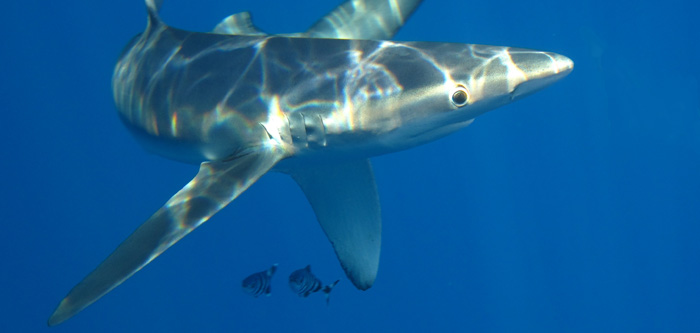Scuba Diving

Shark Diving Expeditions
A HOTSPOT FOR UP CLOSE ENCOUNTERS WITH OCEANIC SHARKS
Many shark species cruise the open ocean but the chances of finding them at any given time are minimal. Fortunately, the Azores are in the migration pathway of some oceanic shark species that cruise the North Atlantic, such as the blue shark (Prionace glauca) and the shortfin mako shark (Isurus oxyrinchus).
Shark diving from Faial takes place in bottomless blue water well offshore. A boat ride of approximately 1 hour takes the divers to Condor Bank, a seamount located about 10 miles Southwest of Capelinhos Vulcano.
Shark diving from Faial takes place in bottomless blue water well offshore. A boat ride of approximately 1 hour takes the divers to Condor Bank, a seamount located about 10 miles Southwest of Capelinhos Vulcano.
How it works
On reaching the chosen area, the skipper will cut the engines and begin to drift. The next chore is to attract the sharks by chumming, creating a scent trail that sharks will follow back to the boat. Thus, a plastic box with fish scraps is hung at 5 m depth, 20 m behind the boat. By using a rigid plastic container the chum is confined and the sharks are not fed, which results in a more controlled and relaxed environment for both sharks and divers. Once the chum is in the water, divers prepare their equipment and wait for the animals to show up. Given sharks’ amazing sense of smell it usually takes less than 30 min. before several sharks, usually blue’s and occasionally shortfin makos, begin to arrive. Once the sharks show up, the dive guide enters the water followed by a small group of up to 6 divers. All divers are encouraged to hover by the boat, holding to the boat’s safety lines. The use of this method avoids divers from drifting into the chum, which could cause a potentially dangerous situation (competition for food). Divers can expect to make a 1 hour dive if good weather, sea conditions and shark activity prevails. Yet, the guide may suspend the dive at any time if the conditions change and could put in risk the divers’ safety.
Blues and makos
Blue sharks are among the most fascinating and graceful creatures. Animals seen are usually 1,5-2 m long and are generally curious, coming close and circling divers, but nonthreatening. With long pectoral fins, pointed snouts and slender bodies their skins glow with a cobalt patina that is iridescent in the sunlight. On such dives, a moment may come when blue sharks suddenly disappear. This usually means a mako or a bigger blue is about to arrive on the scene. Makos sharks are fast-swimmers, often showing up suddenly from the depths. The animals we see are usually relatively small, in the 2 m range. Makos are generally shy around divers, however, they don’t usually stay around for long and, within moments of their leaving, the blue sharks return.
Recommended season: July, August and September
